Duy Nguyen
VirDA: Reusing Backbone for Unsupervised Domain Adaptation with Visual Reprogramming
Oct 02, 2025Abstract:Existing UDA pipelines fine-tune already well-trained backbone parameters for every new source-and-target pair, resulting in the number of training parameters and storage memory growing linearly with each new pair, and also preventing the reuse of these well-trained backbone parameters. Inspired by recent implications that existing backbones have textural biases, we propose making use of domain-specific textural bias for domain adaptation via visual reprogramming, namely VirDA.Instead of fine-tuning the full backbone, VirDA prepends a domain-specific visual reprogramming layer to the backbone. This layer produces visual prompts that act as an added textural bias to the input image, adapting its ``style'' to a target domain. To optimize these visual reprogramming layers, we use multiple objective functions that optimize the intra- and inter-domain distribution differences when domain-adapting visual prompts are applied. This process does not require modifying the backbone parameters, allowing the same backbone to be reused across different domains. We evaluate VirDA on Office-31 and obtain 92.8% mean accuracy with only 1.5M trainable parameters. VirDA surpasses PDA, the state-of-the-art parameter-efficient UDA baseline, by +1.6% accuracy while using just 46% of its parameters. Compared with full-backbone fine-tuning, VirDA outperforms CDTrans and FixBi by +0.2% and +1.4%, respectively, while requiring only 1.7% and 2.8% of their trainable parameters. Relative to the strongest current methods (PMTrans and TVT), VirDA uses ~1.7% of their parameters and trades off only 2.2% and 1.1% accuracy, respectively.
GrAInS: Gradient-based Attribution for Inference-Time Steering of LLMs and VLMs
Jul 24, 2025Abstract:Inference-time steering methods offer a lightweight alternative to fine-tuning large language models (LLMs) and vision-language models (VLMs) by modifying internal activations at test time without updating model weights. However, most existing approaches rely on fixed, global intervention vectors, overlook the causal influence of individual input tokens, and fail to leverage informative gradients from the model's logits, particularly in multimodal settings where visual and textual inputs contribute unevenly. To address these limitations, we introduce GrAInS, an inference-time steering approach that operates across both language-only and vision-language models and tasks. GrAInS uses contrastive, gradient-based attribution via Integrated Gradients to identify the top-k most influential tokens, both positively and negatively attributed based on their contribution to preferred versus dispreferred outputs. These tokens are then used to construct directional steering vectors that capture semantic shifts from undesirable to desirable behavior. During inference, GrAInS adjusts hidden activations at transformer layers guided by token-level attribution signals, and normalizes activations to preserve representational scale. This enables fine-grained, interpretable, and modular control over model behavior, without retraining or auxiliary supervision. Empirically, GrAInS consistently outperforms both fine-tuning and existing steering baselines: it achieves a 13.22% accuracy gain on TruthfulQA using Llama-3.1-8B, reduces hallucination rates on MMHal-Bench from 0.624 to 0.514 with LLaVA-1.6-7B, and improves alignment win rates on SPA-VL by 8.11%, all while preserving the model's fluency and general capabilities.
Multi-Attribute Steering of Language Models via Targeted Intervention
Feb 18, 2025Abstract:Inference-time intervention (ITI) has emerged as a promising method for steering large language model (LLM) behavior in a particular direction (e.g., improving helpfulness) by intervening on token representations without costly updates to the LLM's parameters. However, existing ITI approaches fail to scale to multi-attribute settings with conflicts, such as enhancing helpfulness while also reducing toxicity. To address this, we introduce Multi-Attribute Targeted Steering (MAT-Steer), a novel steering framework designed for selective token-level intervention across multiple attributes. MAT-Steer learns steering vectors using an alignment objective that shifts the model's internal representations of undesirable outputs closer to those of desirable ones while enforcing sparsity and orthogonality among vectors for different attributes, thereby reducing inter-attribute conflicts. We evaluate MAT-Steer in two distinct settings: (i) on question answering (QA) tasks where we balance attributes like truthfulness, bias, and toxicity; (ii) on generative tasks where we simultaneously improve attributes like helpfulness, correctness, and coherence. MAT-Steer outperforms existing ITI and parameter-efficient finetuning approaches across both task types (e.g., 3% average accuracy gain across QA tasks and 55.82% win rate against the best ITI baseline).
Risk-Aware Distributional Intervention Policies for Language Models
Jan 27, 2025Abstract:Language models are prone to occasionally undesirable generations, such as harmful or toxic content, despite their impressive capability to produce texts that appear accurate and coherent. This paper presents a new two-stage approach to detect and mitigate undesirable content generations by rectifying activations. First, we train an ensemble of layerwise classifiers to detect undesirable content using activations by minimizing a smooth surrogate of the risk-aware score. Then, for contents that are detected as undesirable, we propose layerwise distributional intervention policies that perturb the attention heads minimally while guaranteeing probabilistically the effectiveness of the intervention. Benchmarks on several language models and datasets show that our method outperforms baselines in reducing the generation of undesirable output.
Fake Advertisements Detection Using Automated Multimodal Learning: A Case Study for Vietnamese Real Estate Data
Jan 18, 2025Abstract:The popularity of e-commerce has given rise to fake advertisements that can expose users to financial and data risks while damaging the reputation of these e-commerce platforms. For these reasons, detecting and removing such fake advertisements are important for the success of e-commerce websites. In this paper, we propose FADAML, a novel end-to-end machine learning system to detect and filter out fake online advertisements. Our system combines techniques in multimodal machine learning and automated machine learning to achieve a high detection rate. As a case study, we apply FADAML to detect fake advertisements on popular Vietnamese real estate websites. Our experiments show that we can achieve 91.5% detection accuracy, which significantly outperforms three different state-of-the-art fake news detection systems.
LASeR: Learning to Adaptively Select Reward Models with Multi-Armed Bandits
Oct 02, 2024Abstract:Reward Models (RMs) play a crucial role in aligning LLMs with human preferences, enhancing their performance by ranking outputs during inference or iterative training. However, the degree to which an RM generalizes to new tasks is often not known a priori (e.g. some RMs may excel at scoring creative writing vs. math reasoning). Therefore, using only one fixed RM while training LLMs can be suboptimal. Moreover, optimizing LLMs with multiple RMs simultaneously can be prohibitively computationally-intensive and challenging due to conflicting signals from different RMs, potentially degrading performance. To address these challenges, we introduce LASeR (Learning to Adaptively Select Rewards), which iteratively trains LLMs using multiple RMs, selecting and utilizing the most well-suited RM for each instance to rank outputs and generate preference data, framed as a multi-armed bandit problem. Our results on commonsense and math reasoning tasks demonstrate that LASeR can boost iterative LLM optimization by optimizing for multiple RMs, improving the absolute average accuracy of Llama-3-8B over three datasets by 2.67% over training with ensemble RM scores while also showing superior training efficiency (e.g., a 2x speedup). Moreover, on WildChat, a benchmark of instruction-following prompts, we find that using Llama-3-8B LASeR leads to a 71.45% AlpacaEval win rate over sequentially optimizing multiple RMs. Extending to long-context generation tasks, we find that on Llama-3-8B, LASeR achieves an average improvement of 2.64 F1 and 2.42 F1 on single- and multi-document QA over random RM selection when used with best-of-n sampling. LASeR is robust to noisy rewards and generalizes to multiple settings. Finally, LASeR's RM selection changes depending on the underlying task or instance and we verify the presence of conflicting preferences from multiple RMs that can be mitigated using LASeR.
Multi-level Phenotypic Models of Cardiovascular Disease and Obstructive Sleep Apnea Comorbidities: A Longitudinal Wisconsin Sleep Cohort Study
Jun 19, 2024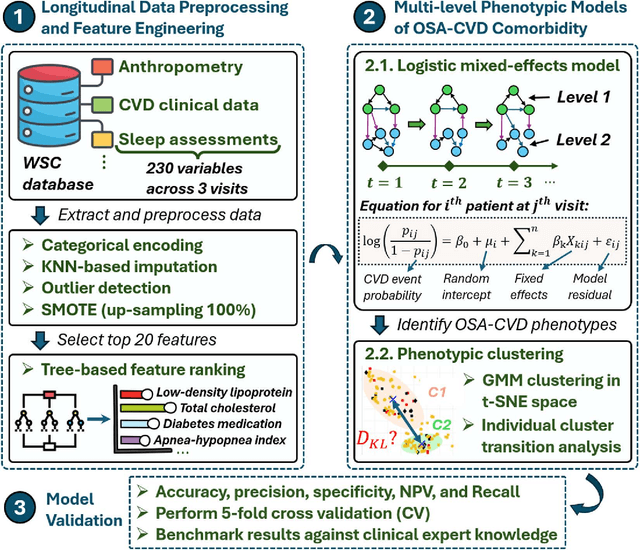

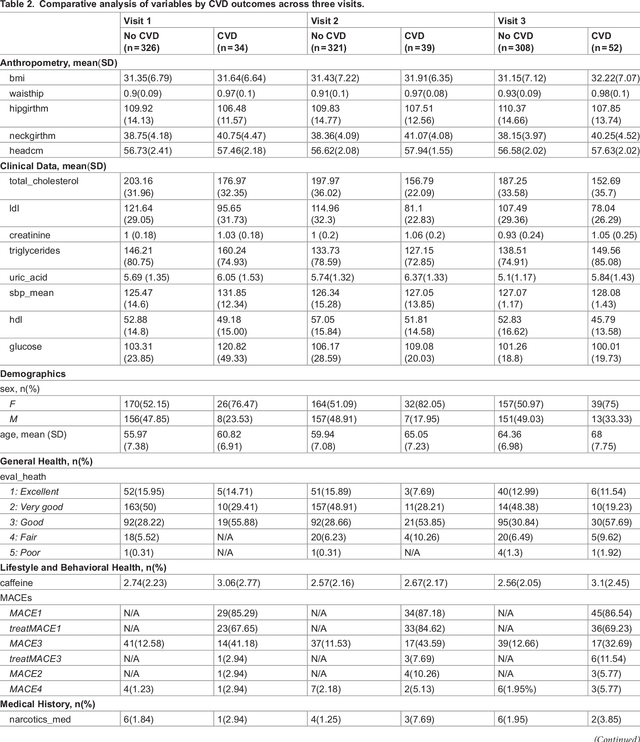
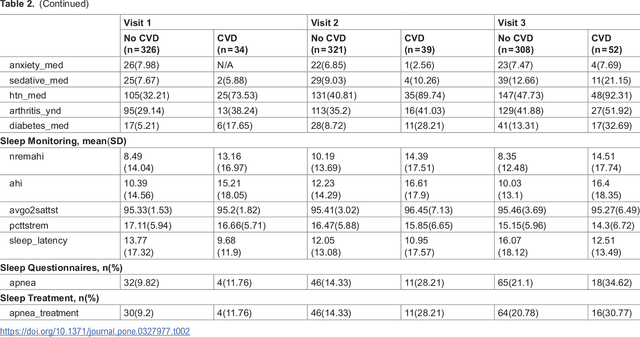
Abstract:Cardiovascular diseases (CVDs) are notably prevalent among patients with obstructive sleep apnea (OSA), posing unique challenges in predicting CVD progression due to the intricate interactions of comorbidities. Traditional models typically lack the necessary dynamic and longitudinal scope to accurately forecast CVD trajectories in OSA patients. This study introduces a novel multi-level phenotypic model to analyze the progression and interplay of these conditions over time, utilizing data from the Wisconsin Sleep Cohort, which includes 1,123 participants followed for decades. Our methodology comprises three advanced steps: (1) Conducting feature importance analysis through tree-based models to underscore critical predictive variables like total cholesterol, low-density lipoprotein (LDL), and diabetes. (2) Developing a logistic mixed-effects model (LGMM) to track longitudinal transitions and pinpoint significant factors, which displayed a diagnostic accuracy of 0.9556. (3) Implementing t-distributed Stochastic Neighbor Embedding (t-SNE) alongside Gaussian Mixture Models (GMM) to segment patient data into distinct phenotypic clusters that reflect varied risk profiles and disease progression pathways. This phenotypic clustering revealed two main groups, with one showing a markedly increased risk of major adverse cardiovascular events (MACEs), underscored by the significant predictive role of nocturnal hypoxia and sympathetic nervous system activity from sleep data. Analysis of transitions and trajectories with t-SNE and GMM highlighted different progression rates within the cohort, with one cluster progressing more slowly towards severe CVD states than the other. This study offers a comprehensive understanding of the dynamic relationship between CVD and OSA, providing valuable tools for predicting disease onset and tailoring treatment approaches.
Cold-start Recommendation by Personalized Embedding Region Elicitation
Jun 03, 2024
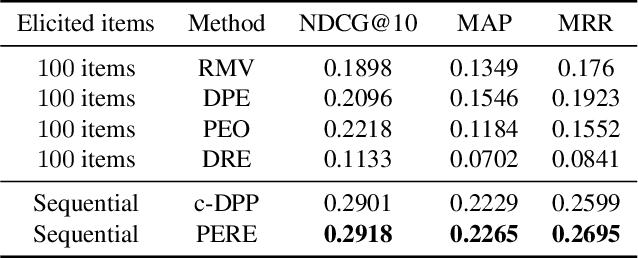
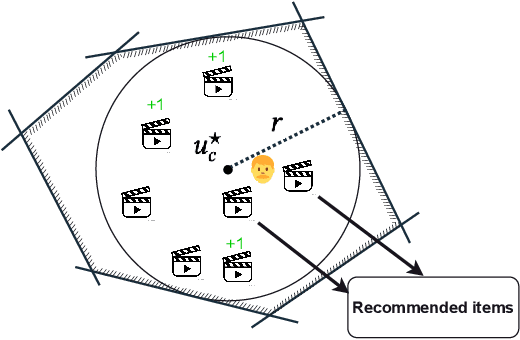
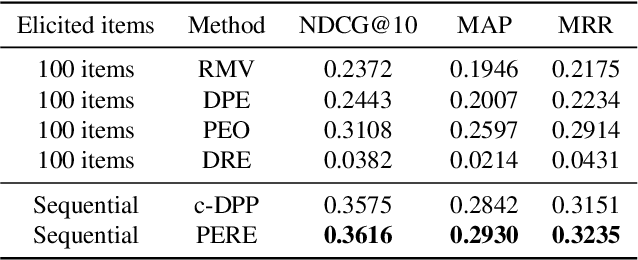
Abstract:Rating elicitation is a success element for recommender systems to perform well at cold-starting, in which the systems need to recommend items to a newly arrived user with no prior knowledge about the user's preference. Existing elicitation methods employ a fixed set of items to learn the user's preference and then infer the users' preferences on the remaining items. Using a fixed seed set can limit the performance of the recommendation system since the seed set is unlikely optimal for all new users with potentially diverse preferences. This paper addresses this challenge using a 2-phase, personalized elicitation scheme. First, the elicitation scheme asks users to rate a small set of popular items in a ``burn-in'' phase. Second, it sequentially asks the user to rate adaptive items to refine the preference and the user's representation. Throughout the process, the system represents the user's embedding value not by a point estimate but by a region estimate. The value of information obtained by asking the user's rating on an item is quantified by the distance from the region center embedding space that contains with high confidence the true embedding value of the user. Finally, the recommendations are successively generated by considering the preference region of the user. We show that each subproblem in the elicitation scheme can be efficiently implemented. Further, we empirically demonstrate the effectiveness of the proposed method against existing rating-elicitation methods on several prominent datasets.
Cost-Adaptive Recourse Recommendation by Adaptive Preference Elicitation
Feb 23, 2024



Abstract:Algorithmic recourse recommends a cost-efficient action to a subject to reverse an unfavorable machine learning classification decision. Most existing methods in the literature generate recourse under the assumption of complete knowledge about the cost function. In real-world practice, subjects could have distinct preferences, leading to incomplete information about the underlying cost function of the subject. This paper proposes a two-step approach integrating preference learning into the recourse generation problem. In the first step, we design a question-answering framework to refine the confidence set of the Mahalanobis matrix cost of the subject sequentially. Then, we generate recourse by utilizing two methods: gradient-based and graph-based cost-adaptive recourse that ensures validity while considering the whole confidence set of the cost matrix. The numerical evaluation demonstrates the benefits of our approach over state-of-the-art baselines in delivering cost-efficient recourse recommendations.
Coverage-Validity-Aware Algorithmic Recourse
Nov 19, 2023



Abstract:Algorithmic recourse emerges as a prominent technique to promote the explainability, transparency and hence ethics of machine learning models. Existing algorithmic recourse approaches often assume an invariant predictive model; however, the predictive model is usually updated upon the arrival of new data. Thus, a recourse that is valid respective to the present model may become invalid for the future model. To resolve this issue, we propose a novel framework to generate a model-agnostic recourse that exhibits robustness to model shifts. Our framework first builds a coverage-validity-aware linear surrogate of the nonlinear (black-box) model; then, the recourse is generated with respect to the linear surrogate. We establish a theoretical connection between our coverage-validity-aware linear surrogate and the minimax probability machines (MPM). We then prove that by prescribing different covariance robustness, the proposed framework recovers popular regularizations for MPM, including the $\ell_2$-regularization and class-reweighting. Furthermore, we show that our surrogate pushes the approximate hyperplane intuitively, facilitating not only robust but also interpretable recourses. The numerical results demonstrate the usefulness and robustness of our framework.
 Add to Chrome
Add to Chrome Add to Firefox
Add to Firefox Add to Edge
Add to Edge